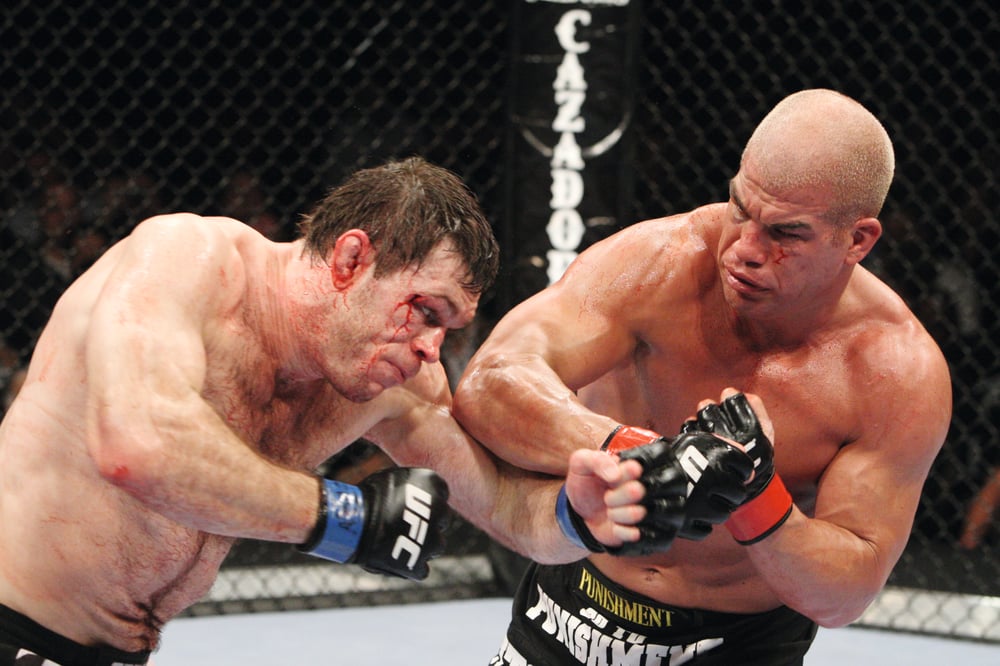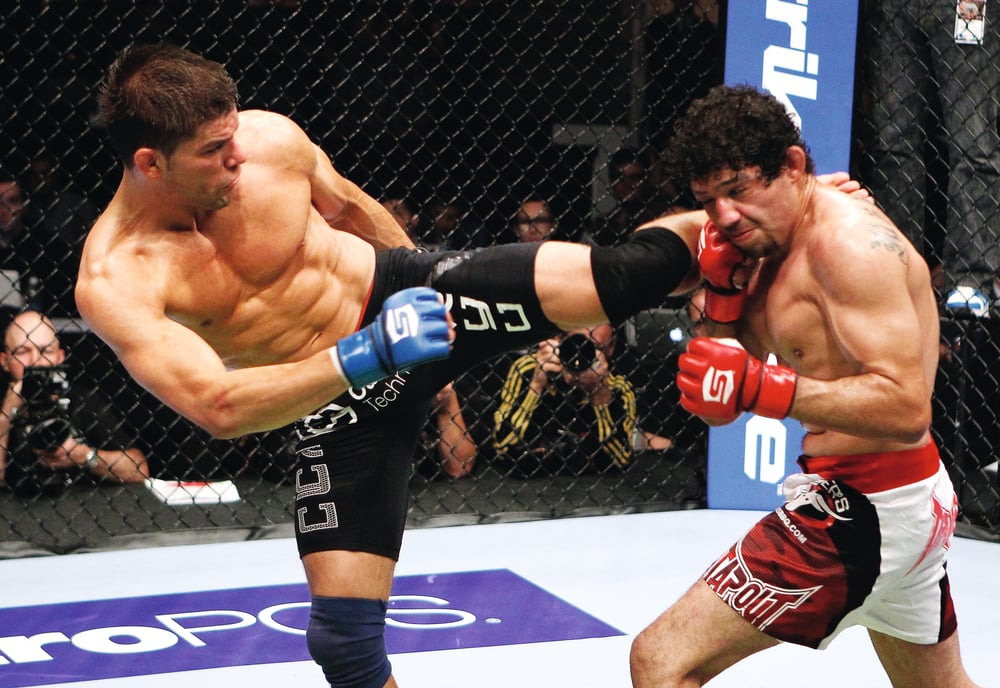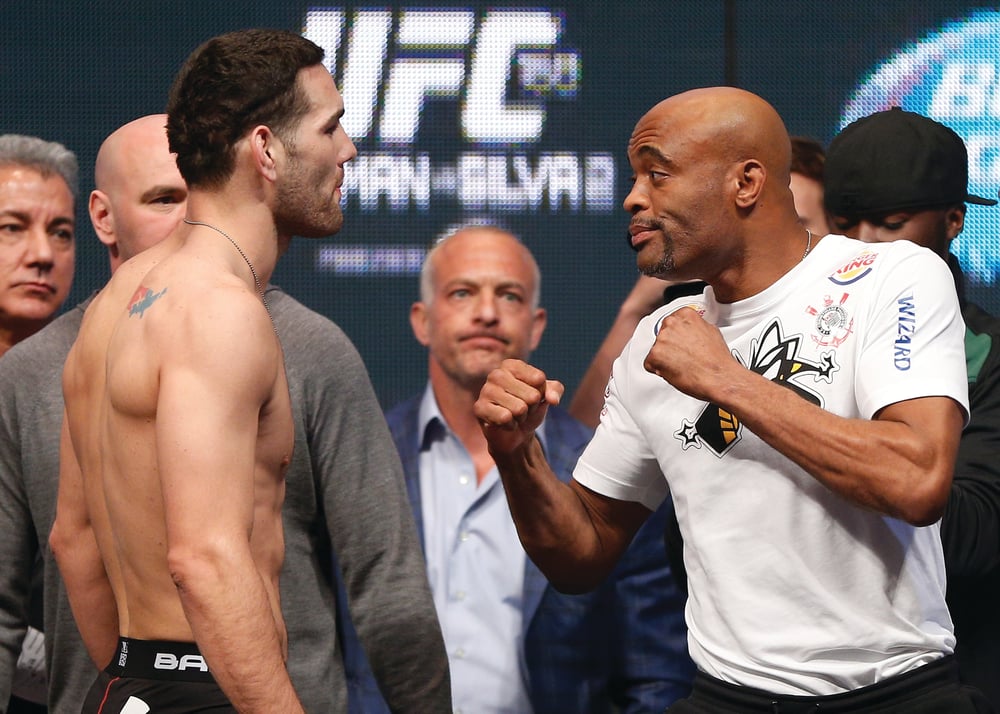
Issue 114
May 2014
Trilogy fights build legacies, attract new fans and transcend the normal boundaries of sport. FO investigates how triple-headers have shaped fight sports and, indeed, mixed martial arts.
The Thrilla in Manila in 1975 is widely recognised as being the ultimate ‘fight of the 20th century’ between two of sport’s most notorious rivals. It was the third in a captivating trilogy between ‘The Greatest’, Muhammad Ali, and ‘Smokin’ Joe Frazier. It was a truly global event and seemingly stopped the world on its axis as boxing’s popularity reached fever pitch in the golden age of the heavyweight division.
Marco Antonio Barrera’s own trilogy of fights with great rival Eric Morales was another occasion when fighters transcended the ring. The sporting world looked on in awe as the two Mexicans slugged it out for eternal bragging rights and world title belts in three different weight divisions throughout the early 2000s.
And no sports fan in their right mind could forget the triple-header featuring Canadian Arturo Gatti and Boston’s Micky Ward, whose own sporting legacies are now forever woven into the patchwork quilt of boxing’s greatest ever wars.
It’s these kinds of rivalries that make great champions. Trilogy matchups that inspire a new generation of fans to the ring. When two athletes are locked in a battle for supremacy over a series of contests, legacies are secured and fight cards go down in history.
Many of boxing’s greatest moments from the past 50 years were a culmination of trilogy campaigns. And the excitement of these super-fights are what has consistently breathed fresh life into a sport that is notorious for going through peaks and troughs from one decade to the next.

And it’s not just fighters and fans who benefit from trilogy fights. From a business perspective, return contests make huge sums of money and can build sporting empires. Going back to Ali-Frazier III in the Philippines, that event truly legitimised Don King as one of the world’s leading fight promoters.
King had emerged from his chequered past a year earlier to stage the ‘Rumble in the Jungle’ in Zaire between George Foreman and Ali. But it was in clinching the fight in Manila that he laid the foundations for two decades at the helm of boxing’s richest fights. It made him, just like it made Frazier and solidified the legend of Ali.
That same trilogy-spawned success can certainly be turned to mixed martial arts and, indeed, its leading organisation, the Ultimate Fighting Championship. Trilogies have punctuated the sport over the past two decades, and one in particular proved to be MMA’s saviour.
UFC president Dana White likes to describe The Ultimate Fighter season one finale as the UFC’s Trojan horse. As the singular event and fight that saved Fertitta brothers Frank and Lorenzo from cutting their substantial losses and walking away from MMA for good. And while there’s now doubting the significance of the first fight between Forrest Griffin and Stephan Bonnar in finally capturing the attention of TV broadcasters and the home audience, it was merely the baited hook.
The card that followed, UFC 52, one of the greatest fight cards in UFC history, could be seen as the real defining moment; the occasion that truly kept the fans coming back for more.
It was the highest grossing UFC event ever at the time, taking over $2.5 million at the gate, and it delivered thrills in spades with standout performances from rising welterweight star Georges St Pierre, a sweet armbar submission from Babalu Sobral, and also Matt Hughes and Frank Trigg contesting one of the greatest fights ever witnessed. But at its true epicentre was the second fight in the generation-capturing trilogy between Randy Couture and Chuck Liddell.
You could argue it was Liddell and Couture’s rivalry, playing out live during the UFC 52 main event and beyond, that retained the imagination of fans who had first been lured to the Octagon by the TUF 1 Finale. It was Chuck and Randy who kept fans travelling back to Las Vegas, more so than any other fighters.
Surely without the epic Couture-Liddell trilogy, Griffin-Bonnar I may never have had the impact it is now rightfully credited with. It was Chuck and Randy’s triple-header in the Octagon that orchestrated the biggest influx of sports fans into mixed martial arts, just like trilogies had done so often before for boxing.

What makes for a great trilogy?
Undoubtedly the biggest factor in all the best trilogy fights throughout history is the third encounter being a rubber-match. When each corner has a win over the other, all is to play for in a third fight, and speculation for success can readily be made for both competitors; after all, there’s a previous victory to validate such an outcome.
When Junior Dos Santos slashed down Cain Velasquez in their first heavyweight title fight back in November 2011 on the very first Fox card, the punch-power of the Brazilian marked him out as being the most destructive fighter in the division. Then in the rematch, Velasquez’s grinding, relentless beat down of JDS rekindked his reputation as the fittest and most skilled heavyweight in history.
So by the time the pair squared off for a third battle at UFC 166, fight fans worldwide were divided – and, of course, glued to the action. Would Dos Santos manage to escape punishment by landing the one strike that could rob the champion of his senses? Or would AKA’s MVP pick up where he left off in the second bout and return his head to the chest of the returning challenger for another systematic beat down?
The answer presented itself in Houston, Texas, in October last year. Dos Santos punched and rolled, but Cain produced another vintage performance to not only bust the lips and puff up the eyes of the Brazilian once more, but also clinch the TKO finish that the very best trilogies necessitate. A definitive victory.
It was the same for Ali and Frazier back in Manila in 1975. Smoking Joe had sensationally outpointed Ali in their first fight in ‘71, while Ali had won a one-sided return in New York three years later. The rubber-match would decide once and for all who ruled supreme, and Ali, in the most epic manner imaginable, came out on top.
While Velasquez-Dos Santos III may not have had the same sociological impact of Ali-Frazier III – and, let’s face it, very few occasions in sports ever have – it’s these legacy-defining moments that champions and fans crave most.
Winning a rubber-match fight against a major rival on the biggest stage possible is truly life changing. It means at the time, in that age, you were the man. It defines careers, often for both athletes, and ensures the sport attracts more revenue, more fans and an enhanced reputation.

MMA trilogies in 2014
This spring, the Bellator lightweight championship will be contested once more by Eddie Alvarez and Michael Chandler. It will be the first pay-per-view Bellator MMA event in history and is undoubtedly the biggest fight to date for the California-based promotion.
As Bellator CEO Bjorn Rebney says: “Sometimes when you put two of the greatest fighters on earth in the cage together, they just give you artistic majesty... I can’t wait to see this fight.” It should take the California promotion, backed by Spike TV in the US, to the next level.
In a perfect storm scenario, Alvarez-Chandler III is set up superlatively, following one victory each in their two previous encounters, which also saw the Bellator 155lb belt passing between them. Both fights, their first in 2011 and the second last November, made the shortlists for ‘Fight of the Year’ at the following Fighters Only World MMA Awards ceremony.
“We’ve had two thrilling fights already that the fans enjoyed so why not do it again?” current champion Alvarez asks. “It’s the perfect fight, with both of us having a win each. It makes sense to close the book on it now with a third fight.”
And Bellator’s pay-per-view special is not the only fan-friendly third confrontation destined for 2014 – or indeed this spring. Back inside the Octagon, two of the UFC’s former trilogy fight favourites, Frankie Edgar and BJ Penn, return for a third meeting of the fists in the TUF 19 super-fight finale.
Both are already a part of a select group of UFC athletes to have featured in big-money trilogy fights. BJ scrapped and scrambled with Matt Hughes for the UFC welterweight tile at both UFC 46 and UFC 63, before reconvening the rivalry in 2010 when BJ won their non-title rubber-match at UFC 123.
While Edgar’s previous trilogy came after he got up close and personal with Gray Maynard during his UFC lightweight title run back in 2011. Their rivalry began in 2008, when Maynard became the first man to defeat Edgar, winning a points decision at UFC Fight Night 13. But the pair went at it again after Edgar replaced Penn as the 155lb title holder, first fighting to a draw in their ‘Fight of the Year’ at UFC 125 before Edgar took the spoils and retained the belt with a ‘Knockout of the Night’ at UFC 136.
Unlike Alvarez-Chandler III, the Edgar-Penn rubber-match comes after two previous back-to-back wins for the New Jersey native. It started when he relieved Penn of the lightweight belt before he went on to secure a decision in the rematch. And with this third fight arriving down at featherweight – BJ’s lightest fighting weight in 13 years of competition – the odds will be tipped in Edgar’s favour.
However, if MMA has shown us anything over the years, it’s that s**t happens. And as far as trilogy fights are concerned – as Rampage Jackson for one can testify after his third-time-lucky victory over Wanderlei Silva – history means nothing when the cage door closes.
Trilogies are huge in combat sports. From a marketing perspective, when a rivalry hangs in the balance, big numbers and huge gate receipts generally follow. And just like when Couture and Liddell’s great three-fight rivalry catalysed a global MMA boom nearly a decade ago, there’s every chance another trio of blockbuster scraps can do the same again. Good things do come in threes.
MMA’s greatest trilogies
We pick out nine of the most action-packed and iconic matchups from the history of mixed martial arts.
1. Fedor Emelianenko vs. Antonio Rodrigo Nogueira
Aside from the headbutt which turned their second fight into a no contest, the Pride title fight meetings between Fedor and ‘Big Nog’ are undoubtedly what helped cement the Russian’s legacy as a genuine heavyweight great. Fedor’s grappling prowess against a jiu-jitsu wizard like Nogueira was truly remarkable, earning decision victories at both Pride 25 and Shockwave 2004. These performances paved the way for a generation of Fedor super fans.
2. Wanderlei Silva vs. ‘Rampage’ Jackson
When you talk about iconic MMA trilogies, this is right up there. Driving Thai knees helped Wanderlei dominate their Pride encounters, winning their first through a TKO in the opening round, before he followed up a stunning right hand and more driving knees to send Jackson face-planting into the ring ropes in their second fight. But, it was Rampage who had the last laugh inside the UFC Octagon. Four years after their second Pride fight he landed a left hook KO of his own to ensure this trilogy reached iconic status.

3. Randy Couture vs. Chuck Liddell
When greatness collides great things happen. Couture won the first fight, hammerfisting his way to victory at UFC 43 and ending Chuck’s hopes of a world title showdown with Tito Ortiz. Then at UFC 52, Chuck finally had a UFC belt to call his own after scoring an emphatic first-round knockout. The two were matched up for the final time at UFC 57, when just moments into the second round Liddell landed a right hook that brought Randy down like a tree and earned Chuck the definitive knockout victory.
4. Georges St-Pierre vs. Matt Hughes
This trifecta of combat signifies the changing of the guard at 170lb, as one welterweight great passed the torch to the next. Veteran champ Hughes won the first fight with a last-second armbar in the first round to claim the vacant title, but St-Pierre fought back into contention and two years later scored a second-round headkick and ground ‘n’ pound TKO to claim the title. The rubber-match was one sided, however, with Georges dominating the vet before an armbar submission deep in the second round.

5. BJ Penn vs. Matt Hughes
It started at UFC 46, when Penn truly arrived as a champion and ended Hughes’ title reign courtesy of a rear naked choke in one of the biggest upsets in history. Hughes would return the favour two years later, halting Penn in the closing stages at UFC 63. And the trilogy was made complete in 2010 when BJ scored a resolute 21-second KO at UFC 123 that banged the penultimate nail into Hughes’ career coffin.
6. Shinya Aoki vs. Joachim Hansen
One of the greatest trilogy fights in Japanese MMA history. When Aoki and Hansen threw down tickets would sell out fast. At Pride Shockwave 2006, submission specialist Aoki drew first blood, with an amazing gogoplata no less. But the Norwegian ‘Hellboy’ captured the inaugural Dream belt by knocking him out in the finals of the lightweight Grand Prix two years later at Dream 5. And the rubber-match finally concluded it all in front of a capacity crowd at Dream 11 when Aoki landed a perfect armbar in the second round.
7. Frankie Edgar vs. Gray Maynard
If just these two names combined doesn’t get you excited then you’re not thinking straight. On two occasions when they met, Maynard had Edgar seemingly beat. But somehow New Jersey’s finest survived and ended with his hand raised. Maynard took an early lead in this trilogy in 2008, being the first man to defeat Frankie. But that was just an appetiser. The main course was their 2011 ‘Fight of the Year’ on New Year’s Day, which was a slugfest from start to finish, and ended in a painful draw. But the third fight, was decisive, as Edgar survived his usual early scare to score a sensation fourth-round KO.

8. Forrest Griffin vs. Tito Ortiz
No titles and no stoppages, yet their three fights were all genuine wars. The first was a thrilling 2006 highlight at UFC 59. The second was a bloody battle of attrition won by late stand-in Griffin at UFC 106. While the third, which went down at UFC 148 in 2012, was another split-decision victory – handing bragging right to Forrest – and earned both a ‘Fight of the Night’ bonus cheque.

9. Josh Thompson vs. Gilbert Melendez
For 25 minutes these two warred for the Strikeforce lightweight title, and still there’s not one clear winner. Sure, Melendez won the rubber-match, but without a finish against one another this is one trilogy that’s still wide open. Thompson dominated the first fight, while Melendez was equally as dazzling in the second. But the third was close. Very close. And while Gilbert is 2-1 up, there’s unfinished business and tickets to be sold, making a fourth fight inevitable.
Make it a treble...
One rivalry MMA fans worldwide are hoping turns into a trilogy is the light heavyweight match up between current champion Jon Jones and leading contender Alexander Gustafsson. After his sensational TKO victory in London, Gustafsson aligned himself to face off against the winner of Jones and latest challenger Glover Teixeira on April 26th. And with the 2013 ‘Fight of the Year’ already in the bank, down the line this could become the biggest world title trilogy in the history of mixed martial arts.
Time to go again?
Here are three awesome UFC rematches we’d certainly pay to see a third time – wouldn’t you?

Lyoto Machida vs. Mauricio 'Shogun' Rua
With one win a piece, plenty of controversy surrounding the judges’ decisions in one fight, and a sensational ground ‘n’ pound knockout in the next, what’s not to love about a possible third fight between the two Brazilians? Sizzling rivalry, unfinished business. And if Machida were to become the next middleweight champion, surely Shogun would also fancy switching down a division to rekindle his title aspirations.
Wanderlei Silva vs. Dan Henderson
This rivalry goes back – way back. Wanderlei and Henderson first fought in Pride in 2000 when Wanderlei recorded a two-round points victory in what was Henderson’s first career defeat in 10 starts. It took another seven years for them to rematch, this time with Henderson scoring a left hook KO in the third round to unify the Pride welterweight and middleweight titles. Now, another seven years on, who doesn’t want to see the two veterans go at it one last time?

Chris Weidman vs. Anderson Silva
OK, so Chris Weidman may have Anderson’s number like coach Matt Serra insists, but still, come on, somewhere deep inside us all we’re still wondering what if. What if Anderson hadn’t played around and left his chin out to dry last summer? What if he hadn’t broken his leg – albeit against Weidman’s keen leg check – at the turn of the year? What if Weidman and Silva did it all again? All those ‘what ifs’ equal just one thing – dollars. Meaning this fight will happen this year or next.
...











